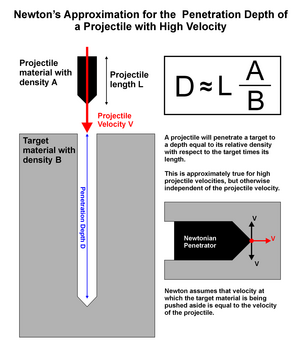Impact depth
This article includes a list of references, related reading, or external links, but its sources remain unclear because it lacks inline citations. (November 2012) |
The impact depth of a projectile is the distance it penetrates into a target before coming to a stop. The physicist Sir Isaac Newton first developed this idea to get rough approximations for the impact depth for projectiles traveling at high velocities.
Newton's approximation for the impact depth

Newton's approximation for the impact depth for projectiles at high velocities is based only on momentum considerations. Nothing is said about where the impactor's kinetic energy goes, nor what happens to the momentum after the projectile is stopped.
The basic idea is simple: The impactor carries a given momentum. To stop the impactor, this momentum must be transferred onto another mass. Since the impactor's velocity is so high that cohesion within the target material can be neglected, the momentum can only be transferred to the material (mass) directly in front of the impactor, which will be pushed at the impactor's speed. If the impactor has pushed a mass equal to its own mass at this speed, its whole momentum has been transferred to the mass in front of it and the impactor will be stopped. For a cylindrical impactor, by the time it stops, it will have penetrated to a depth that is equal to its own length times its relative density with respect to the target material.
This approach is only valid for a narrow range of velocities less than the speed of sound within the target or impactor material.
If the impact velocity is greater than the speed of sound within the target or impactor material, impact shock causes the material to fracture, and at higher velocities to behave like a gas, causing rapid ejection of target and impactor material and the formation of a crater. The depth of the crater depends on the material properties of impactor and target, as well as the velocity of impact. Typically, greater impact velocity means greater crater depth.
Applications
- Projectile: Full metal projectiles should be made of a material with a very high density, like uranium (19.1 g/cm3) or lead (11.3 g/cm3). According to Newton's approximation, a full metal projectile made of uranium will pierce through roughly 2.5 times its own length of steel armor.
- Shaped charge, bazooka: For a shaped charge (anti-tank) to pierce through steel plates, it is essential that the explosion generates a long heavy metal jet (in a shaped charge for anti-tank use, the explosion generates a high speed metal jet from the cone shaped metal lining). This jet may then be viewed as the impactor of Newton's approximation.
- Meteorite: As may be concluded from the air pressure, the atmosphere's material is equivalent to about 10 m of water. Since ice has about the same density as water, an ice cube from space travelling at 15 km/s or so must have a length of 10 m to reach the surface of the earth at high speed. A smaller ice cube will be slowed to terminal velocity. A larger ice cube may also be slowed, however, as long as it comes in at a very low angle and thus has to pierce through a lot of atmosphere. An iron meteorite with a length of 1.3 m would punch through the atmosphere; a smaller one would be slowed by the air and fall at terminal velocity to the ground.
- Impactor, bunker buster: Solid impactors can be used instead of nuclear warheads to penetrate bunkers deep underground. According to Newton's approximation, a uranium projectile (density 19 g/cm3) at high speed and 1 m in length would punch its way through 6 m of rock (density 3 g/cm3) before coming to a stop.
See also
Further reading
- Young, C.W. (1967). The Development of Empirical Equations for Predicting Depth of an Earth Penetrating Projectile (Report). Vol. SC-DR-67-60. Albuquerque NM: Sandia National Laboratories.
- Young, C.W. (1997). Penetration Equations (PDF) (Report). Vol. SAND94-2726. Albuquerque NM: Sandia National Laboratories.
This is a standalone report documenting the latest updated version of the Young/Sandia penetration equations and related analytical techniques to predict penetration into natural earth materials and concrete. See Appendix A & B for intro to penetration equations.
- Alekseevskii, V. P. (1966). "Penetration of a Rod into a Target at High Velocity". Combustion, Explosion, and Shock Waves (Fizika Goreniya i Vzryva). 2 (2): 99–106. doi:10.1007/BF00749237. ISSN 0010-5082. S2CID 97258659.
- Tate, A. (1 November 1967). "A Theory for the Deceleration of Long Rods After Impact" (PDF). Journal of the Mechanics and Physics of Solids. 15 (6): 387–399. Bibcode:1967JMPSo..15..387T. doi:10.1016/0022-5096(67)90010-5. Archived from the original (PDF) on March 26, 2012. Retrieved 23 June 2011.
- Bernard, Robert S. (1978). Depth and Motion Prediction for Earth Penetrators (Report). Vol. ADA056701. Vicksburg, MS: Army Engineer Waterways Experiment Station Vicksburg. Archived from the original (PDF) on October 8, 2012.
- Walters, William P.; Segletes, Steven B. (1991). "An Exact Solution of the Long Rod Penetration Equations". International Journal of Impact Engineering. 11 (2): 225–231. doi:10.1016/0734-743X(91)90008-4.
- Segletes, Steven B.; Walters, William P. (2002). Efficient Solution of the Long-Rod Penetration Equations of Alekseevskii-Tate (PDF) (Report). Vol. ARL-TR-2855. Aberdeen, MD: Army Research Lab Aberdeen Proving Ground MD.
- Segletes, Steven B.; Walters, William P. (2003). "Extensions to the Exact Solution of the Long-Rod Penetration/Erosion Equations" (PDF). International Journal of Impact Engineering. 28 (4): 363–376. doi:10.1016/S0734-743X(02)00071-4. Retrieved 23 June 2011.
External links
- Earth Impact Effects Program
- Space debris penetration depth by velocity and diameter